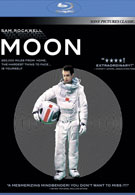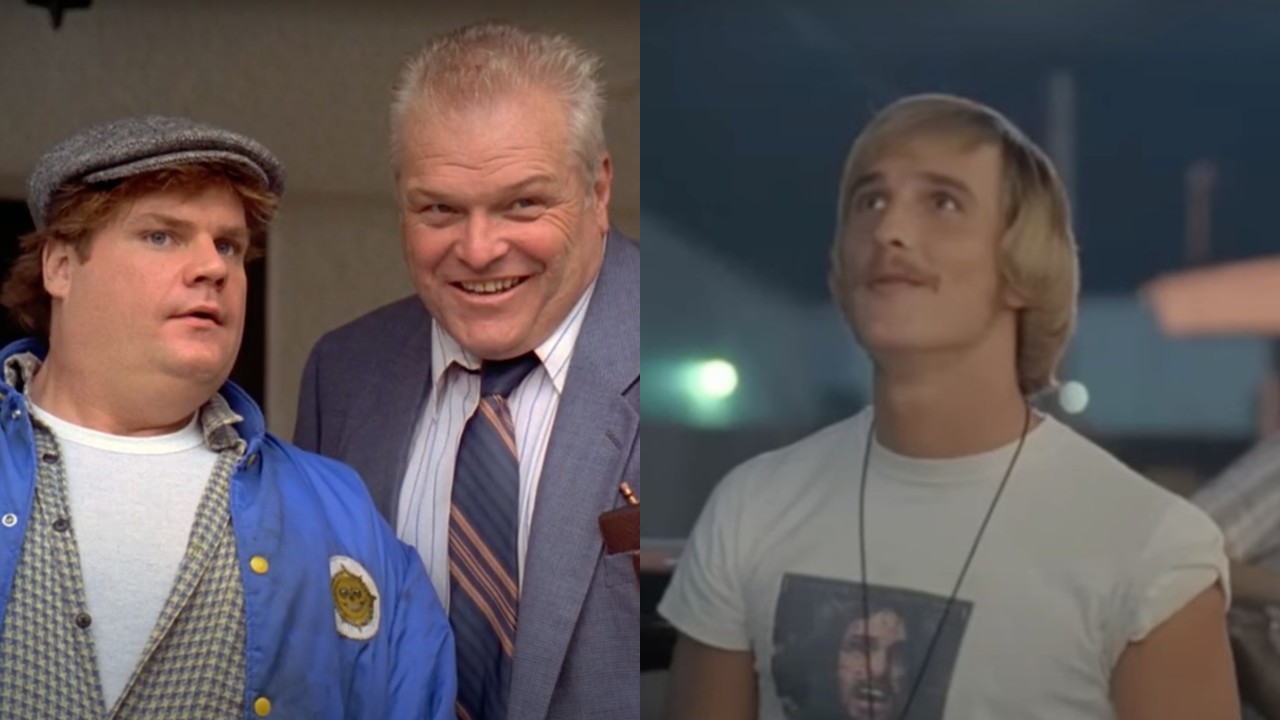Slow films often falter upon a second viewing. Slow films that rely on the jolt of a major plot twist simply crash and burn. Not only is Moon unusual in that it’s a simple and alien-free example of the sci-fi genre, it’s also an exception to the slow-and-twisty rule. After a second viewing, Moon still packs a potent punch, and its ultimate impression is actually enhanced. Sam Bell (Sam Rockwell) is an astronaut working for Lunar Industries. He’s stationed on the Sarang base, contracted to collect helium-3 for three years. In between maintaining the base’s harvesters and sending the collected energy back to earth, he exercises, takes care of his plants, constructs a model town, and enjoys an occasional video message from his wife and daughter back home. His only company is GERTY (voiced by Kevin Spacey), a robotic assistant who’s loyal to the company, but considers taking care of Sam top priority. GERTY is there to offer Sam a smiling face, but with just two weeks left in his contract, Sam’s intense craving for human contact causes strange things to happen, including hallucinations and a growing sense of paranoia.
In just 90 minutes, director Duncan Jones manages to make you feel as though you’re on the moon aboard the Sarang. You’re there with Sam, yet still recognize his solitary situation and sympathize with it. Cash can get you a star-studded cast and mesmerizing special effects, but not necessarily an appealing story. In Jones’ case, the minimalism has bred brilliance.
Jones' use of particular angles and imagery makes you feel as disconnected to earth as Sam. You’re not in the comfort of your home watching a movie, but over 200,000 miles away, seeing the events unfold first-hand. It won’t take long until Sam’s situation makes you squirm in your seat, pained by the monotony of his routine. The monotony and Sam’s gradual mental breakdown combine to create a steadily building sense of anxiousness.
Moon is an impressive directorial debut for Jones, but it’s impossible to overlook Rockwell's moving performance. There are many different layers to Sam Bell, and Rockwell is able to make each one as convincing as the next. What’s particularly interesting about the character is how easily you’re able to identify with his situation. I’ve never been holed up on a base on the moon, yet I understand exactly what he’s going through. More importantly, he’s very convincing, which is particularly vital in making this bizarre story seem sensible. Rockwell takes a complex, multifaceted character and makes him feel real and grounded even as his sanity seems to start slipping. That's something that's even more crucial later in the film, for reasons we won't spoil here.
Moon’s sole slipup is the pace. When there’s action, you’re fully engaged and enthralled, but otherwise, it’s easy to become bored by scenic space shots and harvesters roaming the moon at a snail’s pace. This is never a huge stumbling block, however, because the script, performance, and direction are so good at keeping you connected to the story unfolding. The first time around the slower moments can be frustrating, but during subsequent viewings, they’re actually a blessing. Moon has so many tiny details deserving of attention, the chance to breathe and take in every element of each scene only enhances the experience. SPOILER ALERT
The first items on the bonus-features menu are commentary, but I’d starting with “The Making of Moon.” Much of the commentary references production techniques that will be nearly impossible to imagine without actually seeing the setups. Minus a poorly lit interview with Jones, this featurette provides spectacular visual insight into the making of the film. Much of the focus is placed on the set, which is the interior of the Sarang in its entirety. To further simulate Sam Bell’s experience, the doors were sealed when shooting commenced, leaving the cast and crew to resort to similar methods of entertainment.
The disc comes with two sets of commentary. The first is with Jones, director of photography Gary Shaw, concept designer Gavin Rothery, and production designer Tony Noble. Naturally, much of this commentary is about the set design and its effect on the shooting style. There’s tons of interesting information to be heard, but the conglomeration of British accents makes it impossible to discern who’s saying what. There are also a number of instances where they’re talking over each other. The second commentary, which is just Jones and producer Stuart Fenegan, is far easier to follow. They discuss the filming process as well, but more attention is paid to the story. Both commentaries overlap quite a bit, making listening to both unnecessary.
You get a second dose of redundancy with two Q&A sessions. The first is from a screening at the Houston Space Center and the second after the screening at the Sundance Film Festival. Even though the latter’s got Jones, Rockwell, and a number of the crew members, if you opt to just watch one, I’d choose the Jones solo session at the Space Center. The questions are great and likely coincide with the questions you'll have after watching the film.
The best of the bunch is “Creating the Visual Effects.” With such a minimal budget, a number of drastic and unusual measures were taken to create Moon, and it’s fascinating to learn about them. The piece includes segments on the cloning process, robotics, lunarscapes, and the use of HDRI (high dynamic range imaging).
Jones’ short film Whistle is also included on the disc. I don’t quite understand why, unless it’s just a last ditch effort to get it more attention, but it is rather good. It’s got nothing to do with space or cloning, but, like Moon, has an intriguing unique premise that Jones executes beautifully.
Moon looks fine in Blu-ray hi-def, but the extra clarity doesn’t enhance the viewing experience in the least. All of the same bonus material comes with the DVD edition, so I’d just keep it simple and go for that. Either way, Moon is a riveting tale and worth owning. The shining star of the disc is the movie, but the extras get the job done. Just like the movie itself, you’ll want to watch portions of the special features multiple times just to be sure you haven’t let an iota of juicy detail pass you by.
Staff Writer for CinemaBlend.
Tommy Boy's Director Recalled Matthew McConaughey's Audition For The Movie And How He Filmed It In A 'Room Filled With Mouse S---'
'What The F--k? Of Course We Are.' Marvel Apparently Was Not So Enthusiastic About Florence Pugh Pulling A Tom Cruise And Jumping Off A Building
People Thought Aimee Lou Wood Was Sobbing Over That SNL Debacle, But She Opened Up About The Incident












